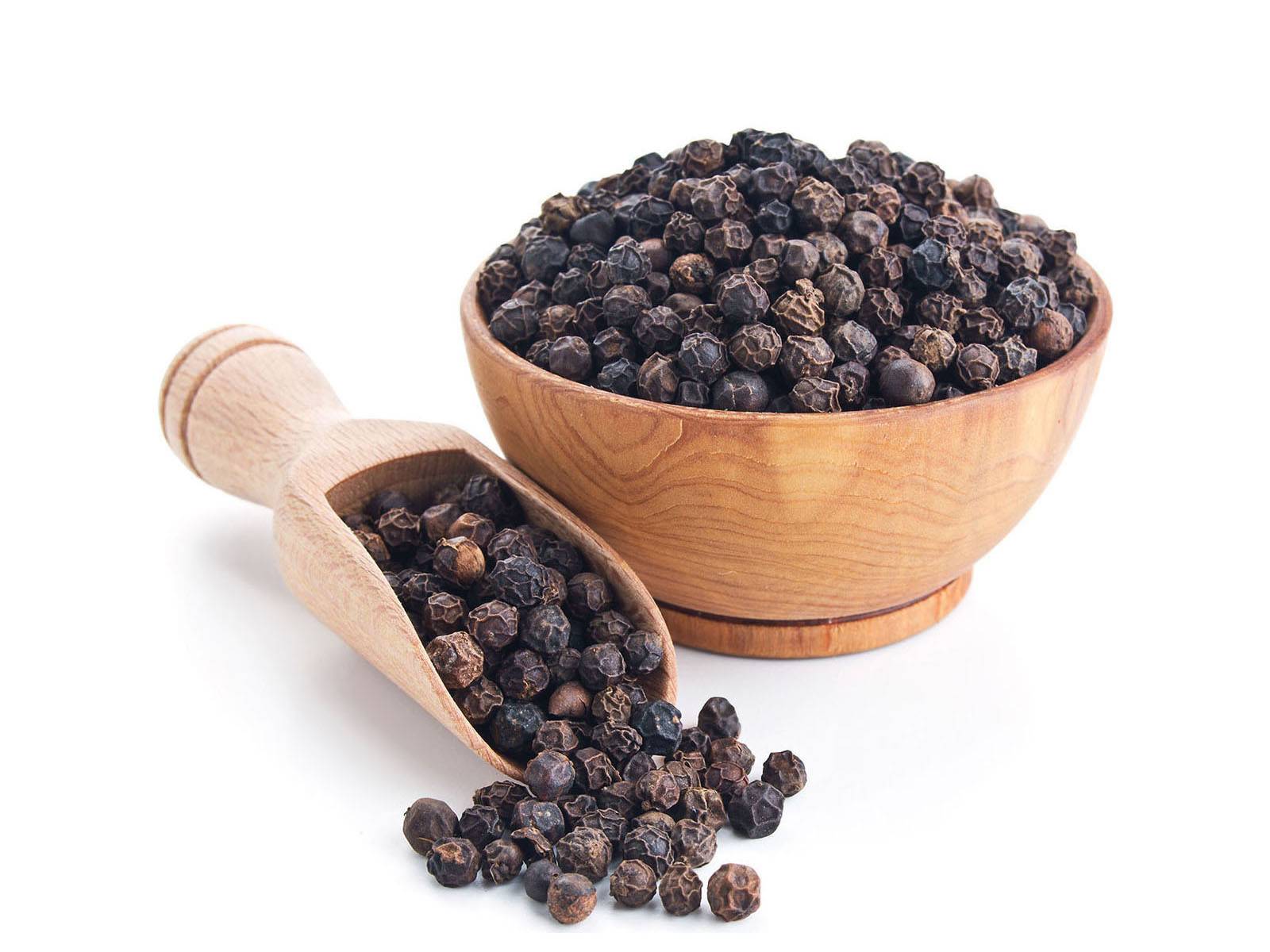Black pepper - Recipes ingridient

Black pepper is a perennial climbing plant, a species of the genus Pepper of the Pepper family. The plant is cultivated for the sake of the fruit, from which spices such as black pepper, white pepper, green pepper, and pink pepper are obtained by various processing.
HOW AND WHERE DOES BLACK PEPPER GROW?
Pepper (Piper) is a genus of evergreen perennial shrubs or creepers, of the Pepper / Piperaceae family, common in the tropical zone of both hemispheres, especially in tropical America, South, and Southeast Asia.
On an industrial scale, several types of pepper are cultivated as spicy, aromatic, and medicinal plants. The most important is black pepper – woody liana, born in the Malabar region (now Kerala), located on the South-West coast of India.
Today, black pepper has been grown in many tropical countries, so that the global pepper crop ripens all year round. From November to March, peppers are harvested in India, from March to May in Vietnam, from May to August in Malaysia, from July to October in Indonesia and Brazil.
Black pepper is obtained from the unripe fruit of the plant. In order to clean and prepare them for drying, fruits are quickly scalded in hot water. Heat treatment destroys the cell wall of pepper, speeding up the work of enzymes responsible for “browning”. The fruits are then dried in the sun or with the help of machines for several days. During this time, the shell of the fruit is dried and darkens around the seed, forming a thin wrinkled layer of black color. Dried fruits are thus called black peppercorns.
White pepper is a ripe black pepper seed devoid of the pericarp. Usually, to obtain white pepper, mature fruits are soaked in water for about one week. As a result of soaking, the shell of the fruit decomposes and softens, after which it separates and dries the remaining seeds. There are alternative ways to separate the shell from the seeds of pepper, including mechanical, chemical and biological.
White pepper has a light gray color, has a more delicate flavor, noble and strong aroma. This spice has almost the same use as black pepper.
Green pepper, like black, is obtained from unripe fruits. Dried green peas are treated in such a way as to preserve the green color, for example, using sulfur dioxide or by lyophilization (dry drying). Similarly, pink (red) pepper is also obtained from ripe fruits (pink pepper from Piper nigrum should be distinguished from the more common pink pepper, made from Peruvian pepper or Brazilian pepper).
Also, green and red peppercorns marinate or used fresh (mostly in Thai cuisine). The smell of fresh peas is described as fresh and savory, with a bright aroma.
COMPONENTS OF ESSENTIAL OIL AND COMPOSITION
The chemical composition of black pepper is represented by a huge number of chemicals (more than 80). Such as fat and essential oils, pitch, starch, gum and alkaloid piperine, causing a burning taste of seeds.
The main components of pepper essential oil are linalool, α-felandrene, limonene, myrcene, α-pinene, 3-methylbutanol and methylpropanol, α-pinene, 1,8-syneol, piperonal, etc. The main component that determines the burning taste of black pepper is the sum of piperine alkaloids.
The essential oil of black pepper is in demand in the food and pharmaceutical industry and is used in perfumery to create oriental fragrances.
MEDICAL PROPERTIES OF BLACK PEPPER
Black pepper can affect the digestive, circulatory and respiratory systems. It is the most powerful and effective stimulator of digestion. In healthy people, it reduces the risk of developing cardiovascular diseases, activates blood circulation and destroys blood clots, but patients with angina, arrhythmia, hypertension can be harmful.
Used for a number of the following diseases:
- chronic indigestion;
- metabolic disease;
- obesity;
- a high fever during colds;
- gives the anthelmintic effect;
- in small doses, it can be consumed with reduced appetite, as well as to enhance the production of saliva and gastric juice;
- has antibacterial properties and can be used externally for the treatment of purulent abscesses;
- in combination with honey, black pepper clears the respiratory organs from mucus and reduces its formation.
The antimicrobial and antioxidant properties of pepper as a natural preservative are still in demand.
METHODS OF APPLICATION OF BLACK PEPPER IN COOKING
- when salting meat and fish;
- in vegetable pickles and marinades;
- in the production of cheeses and meat gastronomy – pies and sausages;
- for soups and broths;
- for roasted meat and game;
- in sauces, dressings, and salads.
Amazing fact! But, black pepper also goes well with mango, watermelon, citrus, and figs, and also perfectly emphasizes the taste of caramel and chocolate. Great for coffee oriental.
Black pepper goes well with other types of peppers: white, green, fragrant, cubeb and other spices.
HOW TO ADD BLACK PEPPER TO THE DISH?
In general, black pepper, like salt, is always on the table. Freshly ground pepper can be added to almost any dish to taste. It is used in recipes from various cuisines all over the world.
To grind pepper, it is more convenient to have a spice mill on hand or simply crush the grain with the flat side of a knife, roll it in a napkin with a rolling pin, and put it in a mortar.
Tip: In a dry skillet, heat several peas well before a characteristic smell. Gourmet: pan can be pre-grated garlic and then dry the pepper.
The complex aroma of pepper quickly disappears, leaving the only hot, so in the long cooking dishes – broths, soups, and stews add whole pepper and closer to the end of cooking.
For frying and roasting meat, fish or poultry, it is better to use white, green or red pepper, and spice up a ready-made dish with black pepper.
The aroma of freshly ground pepper is well fixed and concentrated in an acidic environment. This property is used to make salad dressings and marinades – first, pepper should be mixed with vinegar or sour juices, and only then add oil to the dressing, mixing the mixture thoroughly.
WHOM IS BLACK PEPPER CONTRAINDICATED?
Contraindications to the use of drugs and black pepper dishes are acute pathologies of the gastrointestinal tract (colitis, gastritis, etc.), diseases of the gallbladder, liver, and kidneys.
As well as the use of black pepper should be limited to angina, arrhythmias, and hypertension.
HOW TO CHOOSE AND STORE BLACK PEPPER?
Black pepper berries must be at least 3-5 mm in diameter, of uniform size and color. In some commercial varieties, let’s say a grayish bloom. It is recommended to store ground pepper hermetically packed, otherwise, it quickly exhales and loses its properties, therefore it is better to use purchased pepper at a time, and crushed for six months.
In a word, there is no life without black pepper. Unlike hot peppers, such as “Chile”, black pepper is suitable for all people in terms of its sharpness. And the smell of freshly ground pepper immediately arouses appetite and the desire to eat well.
Recipes with black pepper
Cod baked in the oven with potatoes, tomatoes and bacon
Servings: 4 Cooking time: 1 hour Ingredients 340 g cod fillet New Potatoes 350 g Bacon 6 pieces Cherry tomatoes per 250 g branch Arugula 50 g Lemon 1 piece…
Smoked fish tart with parmesan crust
Servings: 6. Cooking time: 1 hour 10 minutes. Ingredients Grated Parmesan Cheese 25 g; Wheat Flour 110 g; Salt to taste; Lard 25 g; Butter 25g; Water to taste; Smoked…

